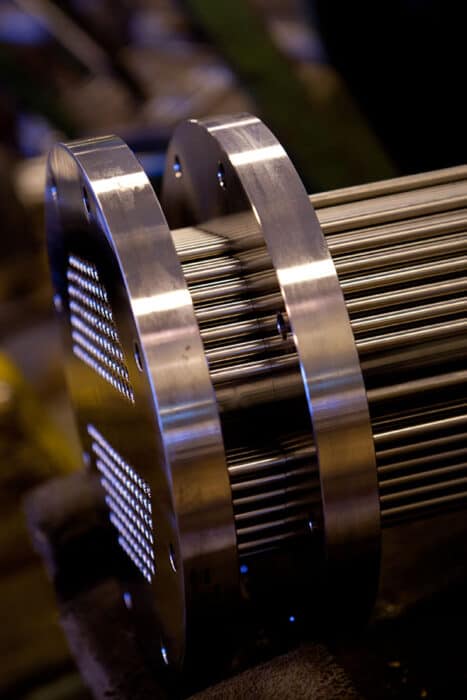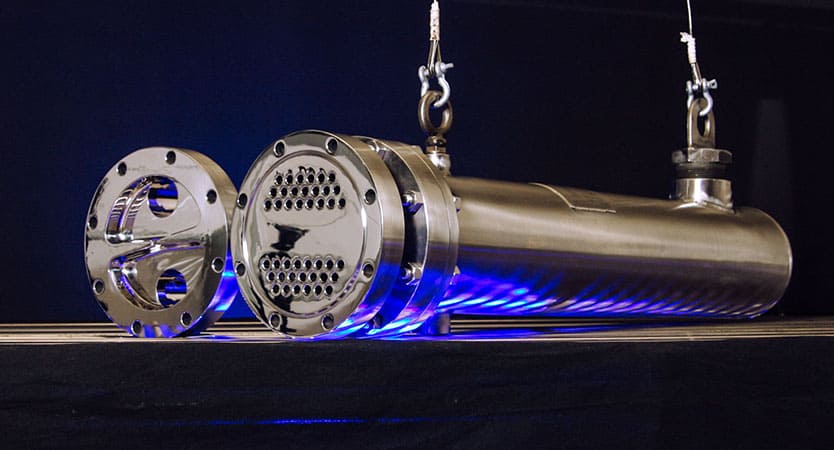In recent decades, there has been a notable surge in regulations and oversight pertaining to pharmaceutical manufacturers. This heightened scrutiny has resulted in stricter design specifications for process equipment. Notably, pharma-grade shell and tube heat exchangers must adhere to stringent criteria. These criteria include ease of cleaning, compatibility with appropriate heat transfer fluids, resistance to contamination and corrosion, and overall reliability. Let’s delve further into why these factors are crucial.
Five Necessary Features of Pharma-Grade Shell and Tube Heat Exchangers
1. Easily Cleaned
Pharmaceutical products must be as pure as possible, and one step in achieving maximum purity is using clean equipment. Residue remaining from the previous batch or product type can taint the next round of product.
Any amount of product left behind that could feasibly be removed through normal cleaning methods should not be present in equipment before production begins, according to the U.S. Food & Drug Administration’s Current Good Manufacturing Practices.
Instruments that test for cleanliness today are highly accurate, able to detect even tiny amounts of residue. As such, it’s not always feasible to clean equipment to the point where absolutely no amount of previous product is detected. However, it’s always best to clean as thoroughly as possible.
Choosing equipment that’s easily cleaned is a good step toward ensuring product batches are as pure as possible. Certain configurations of shell and tube heat exchangers are more easily cleaned than others. For example, straight tube exchangers are often easier to clean than U-tube style exchangers because there are no bends to maneuver around.
Drainability can affect how easy it is to clean a shell and tube heat exchanger. If it’s hard to get the last ounces of liquid out of an exchanger, it’s harder to rid the equipment of all traces of the fluids. Exchangers that are designed to promote drainability, such as those offered by Enerquip, are best for this purpose.
2.Compatible Heat Transfer Fluid
Your equipment needs to be compatible with the substances that will pass through it – both on the tube side and the shell side. The heat transfer fluid used plays a large role in how effective the heating or cooling process is, as well as how well the equipment will hold up in time.
Fluids that aren’t effective for heat transfer will require a longer process time and more energy to run. Additionally, fluids that can be corrosive can cause equipment to wear out faster. Some fluids are flammable, creating potential risks in the work environment if products or equipment are mishandled.
3. Leak-Free
 No manufacturer or equipment operator wants to have leaks. But for pharmaceutical processing equipment, leaks are particularly troublesome. Leaks create the possibility of product contamination, as well as corrosion or other chemical reactions that may occur when process and utility fluids mix.
No manufacturer or equipment operator wants to have leaks. But for pharmaceutical processing equipment, leaks are particularly troublesome. Leaks create the possibility of product contamination, as well as corrosion or other chemical reactions that may occur when process and utility fluids mix.
One way to reduce the risk of leaks is with a fully welded tubesheet. Another method to minimize the risk of leaks – or at least the negative impacts of them – is to design an external leak path to prevent any possible leakage from interacting with the fluid on the opposite side of the exchanger.
Shell and tube heat exchangers constructed with double tube sheets are designed to drain any leakage away from the exchanger to minimize the chances of cross-contamination. At the same time, the operator is alerted to the problem so he or she can address it promptly.
4. Resistant to Contamination and Corrosion
Equipment used to create any product should not pose any risk of contamination. However, avoiding contamination means different things for different industries, processes and products.
To minimize the risk of contamination as much as possible, equipment used for pharmaceutical production should be pharma-grade. Enerquip’s high purity exchangers are ideal for this industry. Our knowledgeable heat exchanger experts have ample experience fabricating shell and tube heat exchangers for pharmaceutical purposes, and are even used by companies like Bristol-Myers Squibb, Pfizer and Unilever.
Corrosion-resistant materials also help to lower the risk of product contamination. Corrosion can be caused by chemical or physical processes, and the residue that emerges through this process can be reactive or can put the purity of the product at risk. Stainless steel and stainless-steel alloys are highly resistant to corrosion, making them smart choices for pharmaceutical construction.
5. Highly Dependable
All manufacturers, regardless of industry, strive to reduce or eliminate downtime. Every minute of downtime has a real impact on the company’s bottom line.
Choosing reliable equipment is one of the most effective ways to reduce downtime. The less frequently equipment requires maintenance or spare parts, the more often it’s contributing to your facility’s production.
Enerquip prides itself on fabricating equipment that is long-lasting and can be counted on. To learn more about choosing the right pharmaceutical process equipment for your facility, contact us today.
More From the Enerquip Blog
- Point-of-Use Water Coolers in the Pharmaceutical Industry
- Double Tube Sheet Design: Importance and Applications
- Heat Exchanger Material Selection based on Common Criteria
- Sani-Matic Testimonial of Enerquip Heat Exchangers
- Preventing Cross Contamination in Your shell and tube heat exchangers
- Investing in a CIP system: Here’s what you need to know
Editor’s note: This content was originally published in 2018 but was updated in 2024.

